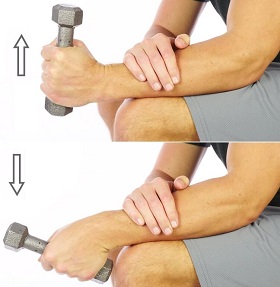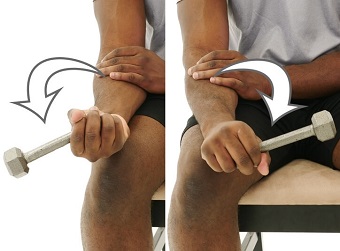- Home
- Elbow Pain Diagnosis
- Forearm Tendonitis
Forearm Tendonitis
Written By: Chloe Wilson BSc (Hons) Physiotherapy
Reviewed By: SPE Medical Review Board

Forearm tendonitis is a common problem that can affect athletes and office workers alike.
With forearm tendonitis, there is irritation or inflammation of one or more of the forearm tendons, usually due to repetitive overuse or an injury.
Common symptoms include an aching or burning forearm pain that gets worse with activities such as gripping or typing, and may be accompanied by weakness.
Forearm tendonitis treatment can usually be done at home and may involve a combination of RICE, exercises and activity modification.
What Is Forearm Tendonitis?
Forearm tendonitis occurs when there is damage to the forearm tendons. Tendons are thick cord-like structures that connect muscle to bone and allow joints to flex, extend and twist. When a muscle contracts, it pulls on the tendon which in turns moves the bone that it is attached to.
Forearm tendonitis can occur in any of the forearm tendons but the two that are most commonly affected are:
- Common Flexor Tendon: connects the five main forearm flexor muscles to the medial epicondyle on the inner elbow. Responsible for controlling wrist and finger flexion
- Common Extensor Tendon: connects the four main forearm extensor muscles to the lateral epicondyle on the outer elbow. Responsible for controlling wrist and finger extension
Our forearm tendons are working constantly during the day, when you’re typing, cooking, playing sports, working out, cleaning, lifting things – the list goes on. This makes the forearm tendons prone to overloading, resulting in micro-tearing and damage to the tendon.
The body responds to this damage by producing inflammatory cells to help heal the injured tissue causing inflammation in the tendon fibers, known as forearm tendonitis.
What Causes Forearm Tendonitis?
Forearm tendonitis is typically caused by either:
- Overuse: doing the same action over and over again results in repetitive strain through the tendon causing inflammation. Common activities that cause overuse forearm tendonitis include racket or throwing sports, manual labor and computer work (keyboard and mouse use)
- Injury: sudden overloading or overstretching through the forearm tendons leads to micro-tearing and inflammation. This may be from things such as heavy lifting, a forceful pull through the forearm or forced hyperextension
Forearm tendonitis is the most common cause of pain in the forearm.
Risk Factors
There are also certain factors that increase your risk of developing forearm tendonitis which include:
- Medical Conditions: e.g. Obesity and type 2 diabetes
- Smoking: slows healing and increase inflammatory markers
- Muscle Imbalance: weakness and/or tightness in the forearm muscles
- Improper Equipment: using tools or rackets that are too heavy or the wrong size e.g. large grip size, or incorrect positioning e.g. keyboard or mouse angle
- Poor Technique: in sports e.g. grip position with racket sports or elbow position with throwing activities
Forearm Tendonitis Symptoms
Common symptoms of forearm tendonitis include:
- Pain: forearm tendonitis typically results in an aching or burning pain in the forearm and/or elbow which may radiate down to the wrist. The tendon may also be tender to touch
- Worse With Activity: forearm tendonitis pain gets worse with activities where you are using the forearm muscles e.g. gripping or twisting activities, and eases with rest
- Weakness: in the forearm and reduced grip strength
- Swelling: there may be some inflammation or a forearm tendonitis lump over the damaged area of the tendon
Forearm tendonitis symptoms will vary slightly depending on which group of tendons are affected:
- Flexor Tendonitis Forearm: pain around the inner elbow and down the front of the forearm towards the pam of the hand. AKA Medial Epicondylitis or Golfers Elbow
- Extensor Tendonitis Forearm: pain around the outer elbow and down the back of the forearm towards the back of the hand. AKA Lateral Epicondylitis or Tennis Elbow
- Wrist Tendonitis: there are a number of tendons that run along the lower forearm and cross the wrist that can develop tendonitis
If you have pain further down your outer forearm, at least 3cm from the elbow, then chances are it is radial tunnel syndrome, where there is irritation of the radial nerve rather than tendonitis.
Diagnosing Forearm Tendonitis
Forearm tendonitis can usually be diagnosed by your doctor taking a full history and examining your neck, shoulders and arms. They will carry out specific forearm tendonitis tests such as:
- Palpation: over the tendon for pain and inflammation
- Resisting Wrist & Hand Movements: there are a number of specific forearm tendonitis tests e.g. Cozen’s Test & Mill’s Test
- Assessing Grip Strength: for pain and weakness compared to your other arm
They may also want to send you for various tests e.g. x-ray or ultrasound scan to rule out other possible causes.
Forearm tendonitis is just one possible cause of inner elbow pain and outer elbow pain. If forearm tendonitis isn't sounding quite like your problem, visit the elbow pain diagnosis or forearm pain diagnosis sections.
Forearm Tendonitis Treatment
In most cases, forearm tendonitis treatment can be done at home. The best home remedies for forearm tendonitis are:
1. RICE
The best place to start with forearm tendonitis treatment is RICE which stands for Rest, Ice, Compression & Elevation
- Rest: Resting from aggravating activities is a vital part of forearm tendonitis treatment. Given that in most cases tendonitis is an overuse injury, it is important to avoid any aggravating activities as much as possible to allow the tendon to heal. If you keep aggravating the tendon, it’s like you are picking off a scab and the healing process has to start all over again and it will take much longer to recover
- Ice: Regularly applying ice is a helpful forearm tendonitis treatment tool as it helps to reduce both the pain, spasms and inflammation in the tendon. Apply an ice pack for 10-15 minutes every couple of hours to get the best results
- Compression: wearing a compression bandage such as tubigrip compression for forearm tendonitis can help to support the forearm and reduce swelling
- Elevation: if there is significant swelling with your forearm tendonitis, then keeping the arm elevated above the level of your heart will help to reduce the swelling
2. Medication
Medications can also help to treat forearm tendonitis. Over-the-counter pain relief mediation e.g. paracetamol/acetaminophen and non-steroidal anti-inflammatories (NSAIDS) e.g. ibuprofen/Advil can work well but check with your doctor or pharmacist before taking any new medication.
If you have to continue with activities that you know will aggravate your forearm tendonitis, time when you take your medication so it can have maximum effect. A good tip is to take medication 30 minutes prior to exercise/activity.
3. Injections
Corticosteroid injections can be a useful part of forearm tendonitis treatment, particularly in the more acute phase. A mixture of anaesthetic and steroid solution is injected into the affected forearm tendonitis lump which helps to reduce pain and inflammation. Some people notice the benefits immediately, for others it can take a few days.
Ideally injections should be carried out under ultrasound guidance to ensure the right part of the tendon is injected. Steroid injections do temporarily weaken the tendon so it is really important to rest for a few days and not put any strain through the tendon otherwise there is a risk of tendon rupture. And repeated injections into a forearm tendonitis lump should be avoided, again due to tendon weakening.
4. Ergonomic Assessment
If your forearm tendonitis is due to spending long periods doing desk work or on the computer it is worth looking at your desk set up. It is common for your wrist to be in an extended position when using a keyboard of mouse which increased the risk of developing forearm tendonitis.
Using a wrist rest to ensure your wrist is in a neutral position can make a big difference. And if it is your mouse hand that is affected, try swapping your mouse over to the other hand – it will feel awkward at first but can be easier than trying to co-ordinate a wrist rest with the mouse.
5. Physical Therapy For Forearm Tendonitis
In most cases, your doctor will recommend physical therapy for forearm tendonitis. Not only will a physical therapist be able to give you a personalised rehab programme, they may use other treatments for tendonitis in the forearm such as:
- Massage: Deep tissue transverse friction massage (DTFM) can be used to reduce inflammation and realign the collagen fibres as the tendon heals to help you regain full strength and flexibility in the tendon. DTFM’s should be done regularly so your physical therapist should show you how to do them yourself so you can do them at home
- Ultrasound: often used alongside DTFM, ultrasound also helps to realign collagen fibres and speed up healing by bringing in the right healing nutrients and getting rid of the inflammatory chemicals in the tendon. The evidence for using ultrasound for treating tendonitis is mixed, but there have been some very positive results
6. Forearm Tendonitis Brace
Some people find wearing a forearm tendonitis brace or strap really helps as part of their treatment plan. The most common options for a forearm tendonitis brace are:
- Forearm Strap: A forearm tendonitis band, aka counterforce brace/strap, wraps around the forearm just below the elbow and helps direct strain away from the inflamed tendon.
Counterforce straps are particularly useful when you start returning to sport as not only do they reduce pain when using the forearm muscles, they also helps to protect the forearm tendons from further overloading and damage - Wrist Splint: Some people with forearm tendonitis find it helpful to wear a wrist splint for a few weeks while their symptoms settle. A wrist splint holds the wrist in a neutral position so there is less strain through the tendons when using the forearm muscles. It is important to make sure you are doing forearm tendonitis exercises as well otherwise the muscles are likely to get weaker and tighter if you are wearing a splint all the time
7. Forearm Tendonitis Exercises
Exercises are a really important part of forearm tendonitis treatment to combat any weakness and tightness in the forearm muscles. Ideally, you want to do a combination of strengthening and stretching exercises for forearm tendonitis:
- Forearm Stretches Tendonitis: stretching out the forearm muscles helps to reduce the tension and strain through the forearm tendons. Forearm flexor stretches are particularly good with medial tendonitis and forearm extensor stretches are good for lateral tendonitis.
- Strengthening Exercises: for forearm tendonitis also really help and all you need is a hand weight or a can of tinned veg
There are a number of different forearm tendonitis exercises that can help and here are a few to get you starts.
For each of these exercises, sit with your forearm resting on the arm of a chair, holding a weight/can in your hand. Let your wrist rest just off the end of the chair arm so your hand hangs freely. With each of these exercises the movement should come from your wrist – keep your forearm, elbow and shoulder still.
Forearm Flexor Strengthening

- Start by turning your forearm so your palm faces upwards
- Bend at the wrist and bring your hand up towards you
- Hold for 2 seconds and slowly lower your hand down so the wrist bends back as far as is comfortable
- Repeat 10-25 times
Forearm Extensor Strengthening

- Start by turning your forearm so your palm faces downwards
- Bring your hand up towards you, extend at the wrist and lift the weight
- Hold for 2 seconds and slowly lower your hand down so the wrist flexes down as far as is comfortable
- Repeat 10-25 times
Forearm Deviator Strengthening

- Turn your forearm so your thumb is facing the ceiling
- Leading with your thumb, lift your wrist up towards the ceiling and hold for 2 seconds
- Slowly lower you hand back down and hold for 2 seconds – the action is similar to when you use a hammer
- Repeat 10-25 times
Forearm Rotation Strengthening

- Start with your thumb pointing towards the ceiling
- Slowly turn your wrist inwards so your palm faces down, hold for 2 seconds
- Slowly turn your wrist outwards so your palm faces the ceiling, hold for 2 seconds
- Repeat 10-25 times each way
Forearm Stretches Tendonitis
- Stretch your arm out in front of you so your elbow is straight, palm facing down (no weight needed for this one!)
- Grasp the fingers on your affected hand and draw your fingers and wrist back towards you to stretch your forearm flexors
- Hold for 20-30 seconds and repeat 3 times
- Then bend your wrist down and gently push through the back of your hand to stretch your forearm extensors
- Hold for 20-30 seconds and repeat 3 times
Top Tips With Forearm Tendonitis Exercises
If any of these forearm tendonitis exercises irritate your symptoms or cause any pain, try using a lighter weight and/or reduce the number of repetitions. You may find some of these exercises for forearm tendonitis easier than others so don’t feel you have to do the same number or use the same weight for each – just do what works best for you.
These forearm tendonitis exercises are a great place to start, but there are other exercises that can also help to further stretch and strength the forearm muscles – check out the medial tendonitis exercises section to find out more.
8. Forearm Tendonitis Surgery
Forearm tendonitis surgery is usually only necessary if there is a significant tear in the tendon, the tendon has torn away from the bone or significant scar tissue has built-up in the tendon. In most cases, surgery is only considered if symptoms persist after six months of forearm tendonitis treatment.
Forearm tendonitis surgery will look to remove any scar tissue, repair any tears in the tendon and/or re-attach the tendon to the bone if necessary.
Recovery from forearm tendonitis surgery usually takes 1-3 months with a combination of physical therapy, exercises and in some cases splinting.
Summary
Forearm tendonitis is a common cause of forearm pain that often extends to the elbow and hand. It is most typically caused by overuse and repetitive strain through the tendon. The sooner you start forearm tendonitis treatment, the quicker symptoms will subside.
Forearm tendonitis treatment typically involves a combination of rest, medication, exercises and physical therapy and some people benefit from wearing a forearm tendonitis brace. Symptoms usually settle within 3-12 weeks with correct forearm tendonitis treatment.
You can find out more about the two most common types of forearm tendonitis and how to treat them:
- Medial Tendonitis: pain and inflammation on the inner elbow and front of the forearm. AKA Golfer’s Elbow
- Lateral Tendonitis: pain and inflammation on the outer elbow and back of the forearm. AKA Tennis Elbow
Tendonitis can affect any of the tendons in the arm and other than forearm tendonitis, the most common types of arm tendonitis are:
- Biceps Tendonitis: pain at the front of the elbow and top of the forearm
- Triceps Tendonitis: pain at the back of the elbow
- Supraspinatus Tendonitis: pain and inflammation at the front and top of the shoulder
- Intersection Syndrome: pain on the back of the forearm just above the wrist
- Wrist Tendonitis: inflammation of one of the wrist tendons
- De Quervain Tenosynovitis: Inflammation of the thumb tendon sheath
If none of these are sounding like your problem, visit the elbow pain diagnosis or pain in the forearm sections for help working out what's wrong.
Related Articles
Page Last Updated: November 14th, 2024
Next Review Due: November 14th, 2026



